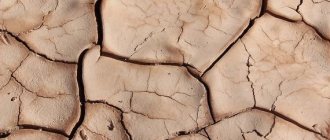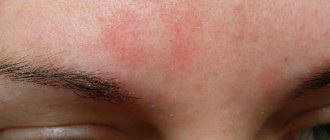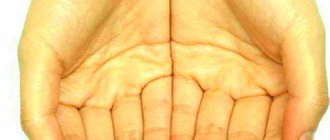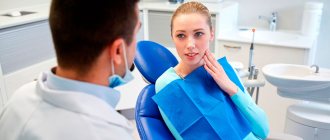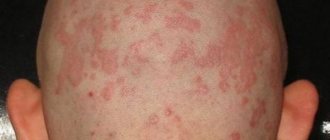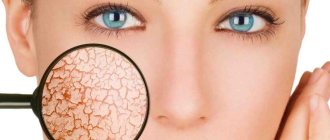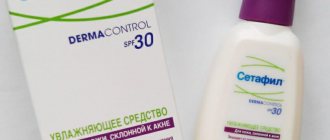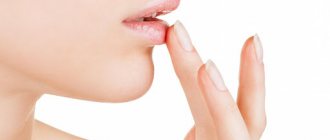Dry patches on the skin are quite common. They can appear at almost any age - both in infants and in adults and the elderly. There are a number of reasons that cause dry patches on the skin. However, not in all cases it is possible to find out the true cause of this disease. In any case, a medical examination is required to select effective treatment.
Dry spots, different in structure from normal skin, often occur in completely healthy people. Sometimes these phenomena are short-term in nature and go away on their own without requiring treatment. But there is a set of factors whose presence should alert you:
- the size of the spot gradually increases, its peripheral growth is observed;
- the stain does not disappear for quite a long time;
- after disappearing it may appear again;
- dry spots itch and itch and cause discomfort;
- ulcers, papules, and other rashes form;
- Similar symptoms appear in other family members.
Are you experiencing similar symptoms? See a doctor urgently! Sometimes skin problems signal the presence of serious diseases in the body.
Doctors name several reasons why dry patches may appear on the skin. Let's look at them briefly:
- Allergy. It is one of the most common causes of rashes due to contact with an allergen (cosmetics, medications, berries or fruits, etc.). Elimination of the allergen and appropriate therapy brings the situation back to normal.
- Fungus. It is often a provoking factor for the appearance of skin rashes and various spots. Requires serious and often persistent treatment.
- Stress. Psycho-emotional outbursts are often accompanied by skin problems.
- Changes in temperature and humidity. Seasonal dermatitis is a common and common occurrence. Frost, wind, and UF rays have a negative impact on the skin, leading to the appearance of dry spots and skin rashes.
- Dermatological diseases. The presence of dry patches is characteristic of some skin diseases.
- Diseases of the endocrine system and gastrointestinal tract. The skin reacts sharply to the presence of thyroid diseases and problems with the digestive system.
- Autoimmune diseases. Failure of the immune system leads to serious problems, including skin problems, including the development of necrotic processes.
Dry red patches on the skin
Almost all of us have encountered the phenomenon of dry red spots on the skin. They can occur when the body is exposed to irritating factors, in other words, allergens. It is allergens that in most cases provoke negative skin reactions, red rashes, often forming large areas of allergic damage. These rashes are characterized by itching and irritation.
Red spots that suddenly appear on the skin are characteristic symptoms of developing psoriasis. This disease is extremely difficult to treat. Consultation with a dermatologist is required. In some cases, stable remission can be achieved by following a special diet; long-term complex therapy under the supervision of a specialist is required.
Effective methods for treating psoriasis on the legs
The following methods used in our clinic have been proven to be highly effective:
- PRP therapy - the essence of the method is that the patient is injected with his own blood enriched with platelets; Initially, blood is taken from a vein and injected pointwise into the affected areas of the skin of the legs; this leads to improved metabolic processes and suppression of the spread of psoriasis; helps well with all forms of disease;
- autohemotherapy - intramuscular injection of blood taken from the patient’s vein; has a general stimulating effect on the body;
- herbal medicine – the use of herbs and other medicinal plants. They are used as part of complex therapy to reduce the drug load on the patient’s body;
- acupuncture (acupuncture) is one of the methods of reflexology, the oldest method practiced by Chinese doctors; influence on special acupuncture points (AP) on the body and through them on various organs and tissues; specialists who are fluent in this technique can eliminate psoriatic rashes without the use of medications;
- vacuum therapy – exposure of the AT to rarefied air; for this purpose, special jars or devices are used;
- other methods of reflexology - cauterization with wormwood cigarettes, acupressure, auriculotherapy (impact on reflex points on the ear), etc.
How is leg psoriasis treated at Paramita Clinic?
A special feature of the Paramita clinic is the use of only effective methods of treating psoriasis on the legs at an affordable price. Both the most advanced European techniques and traditional oriental ones are used.
The correct choice and application of one or another method of therapy is possible only if the doctor has appropriate training and clinical experience. The clinic's doctors are fluent in all known methods of treating psoriasis, so it always takes place without side effects. All of them were trained in traditional healing methods in China and Tibet.
To avoid relapses, it is necessary to eliminate the cause of the disease.
Read more about our unique method of treating psoriasis
You can learn about the quality of treatment provided by Paramita specialists from reviews, as well as simply by asking visitors, because many of them are systematically treated at the clinic, maintaining a state of remission for years.
Brown dry patches on the skin
With age, you can observe the appearance of brown dry spots on the skin. Changes in skin pigmentation and slight peeling may also appear during pregnancy. In both cases, the appearance of dark spots is not a pathology; these are natural processes that do not require treatment.
In the first case, the appearance of spots is associated with the aging process and the problem can be solved using special cosmetics, at home - masks with lemon. Brown dry spots on the skin of pregnant women can occur due to hormonal changes in the body. The problem is resolved without drug treatment, and after childbirth the pigmented spots disappear.
Pay special attention to new growths that appear that look like moles. Dangerous signs that require immediate treatment are the rapid growth of a mole, changes in its color and structure, the presence of uneven edges, pain, itching and bleeding. These signs are characteristic of cancer - melanoma.
Psoriasis on the knees
The manifestation of psoriatic rashes on the extensor surface of the knee joints is typical.
Psoriasis on the knees begins with the appearance of a small round or oval-shaped spot. The spot gradually turns into a papule with a raised, inflamed base. The early plaque is covered with silvery scales on top and is surrounded by a brighter corolla that rises above its surface and has no scales. If you scratch the papule, first the appearance of a stearin stain appears, and then a thin transparent film. Further exposure to the film is accompanied by the appearance of droplets of blood—blood dew—on its surface. In the initial stage of psoriasis of the legs (also called progressive), there may be one or two papules, then several more appear and they grow, merge with each other, forming large plaques of various configurations. The appearance of new rashes at the site of injury to the skin - scratches, abrasions, etc. is typical.
Psoriasis often stops at the initial stage and plaques in the knees, feet, and legs can be seen for several years and even decades. Such plaques are called duty plaques. With additional exposure to provoking factors, psoriasis can enter a progressive stage at any time, spreading from the legs to other parts of the body.
The next period is called stationary. The spread of the psoriatic rash stops and it looks the same all the time. After some time, the final regressive stage begins, when the rash gradually fades. The process can take place in two directions:
- from the center to the periphery - a pink corolla forms around the papule;
- from the periphery to the center - the corolla is white.
Gradually, white or brownish pigment spots form at the site of the rash. The process proceeds in waves: exacerbation is replaced by remission and vice versa.
Dry flaky patches on the skin
If you have dry, flaky patches on your skin, don’t rush into panic; perhaps this is how your skin reacts to a lack of moisture. To ensure that metabolic processes in the body proceed normally, do not forget to drink enough water. For an adult, the norm of fluid intake (all fluid entering the body is taken into account) is 1.5-2 liters. A healthy and balanced diet is the main condition for maintaining normal skin.
The problem of dry and flaky skin can be solved with the help of moisturizing cosmetics. Give preference to preparations with vitamin E. This vitamin perfectly combats dry skin and is recommended for the prevention of eczema. If the desired effect does not follow, consult a doctor. The appearance of dry, flaky patches may indicate a serious illness. A visual examination by a specialist, as well as laboratory diagnostics, will allow you to establish the exact cause for effective treatment.
How to deal with itchy skin
But what if a dry spot on the skin itches, but you can’t go to the doctor in the near future? In this case, you can alleviate the condition with the help of antihistamines, most of which are sold in pharmacies without a prescription. Try not to scratch the spots; it is better to lubricate the affected areas with anti-itch gel so as not to aggravate the situation. And, of course, do not neglect visiting a doctor. It is also necessary to review your diet and eliminate foods that provoke allergic reactions. In winter, it is necessary to ensure that the air in the room is not too dry. In summer, do not stay in direct sunlight for long periods of time.
White dry patches on the skin
Why do white dry spots appear on the skin? It is impossible to answer the question unequivocally. Among the reasons that provoke the appearance of such spots are the following:
- Prolonged exposure to the sun. Burnt skin peels off unevenly (popularly called “flaking”), resulting in the appearance of whitish areas on the skin. To normalize the condition, it will take some time - 1-2 weeks and the use of special cosmetics.
- Vitiligo. A disease associated with impaired pigmentation of the skin. At the same time, in some areas the skin looks as if it is discolored, in fact it is, since the coloring pigment melanin is completely absent there.
The onset of the disease can occur at any age. The hands, face, knees, and elbows are most often affected. The nature of the disease is not fully understood. With vitiligo, white spots cause only aesthetic discomfort. The disease is practically untreatable. Sometimes the spots disappear spontaneously. It is recommended to take antioxidants and immunomodulators. Be careful with sun exposure and contact with phenol derivatives.
- Pityriasis versicolor or versicolor. The appearance of whitish spots is characteristic of infection with pityriasis versicolor. A chronic disease that affects the stratum corneum of the epidermis. Drug treatment is required.
Why does psoriasis develop on the legs?
Psoriasis on the legs is a chronic skin pathology that has a hereditary predisposition. The development of the disease is facilitated by the influence of predisposing factors. Factors predisposing to the development of psoriasis on the legs:
- Limb injuries - abrasions, cracks, wounds. In people prone to this pathology, they often become inflamed, accompanied by itching, and scratching. Against this background, psoriatic rashes appear. These causes most often cause psoriasis in the knee joints in children, adolescents and athletes.
- Skin diseases and foot abrasions. The disease especially often develops against the background of fungal infections. It is important to wear tight shoes, in which the feet sweat and get injured.
- Metabolic disorders, obesity, diabetes mellitus, endocrine diseases, age-related hormonal imbalances, pregnancy. Any hormonal imbalance can cause the onset of the disease.
- Any chronic processes and foci of infection leading to intoxication of the body.
- High emotional, mental and physical stress.
- Improper, irregular diet, intestinal dysbiosis.
- Immunity disorders.
Psoriasis of any localization can spread throughout the body, so do not delay treatment.
See how easily the disease can be cured in 10-12 sessions.
Exposure to one or more predisposing factors causes a chain reaction in the body:
- metabolism is disrupted;
- biologically active substances are released that stimulate the rapid division of surface cells of the skin epithelium; the formation of scales and peeling begins;
- Antibodies to your own skin cells are formed in the blood, an autoimmune inflammatory process begins - characteristic papules appear.
Psoriasis on the legs can develop on different parts of the skin, but most often the rash appears on the knees and feet. It also looks different.
Who to contact for skin diseases
If there are no serious reasons for concern, and you observe individual skin imperfections, consult a cosmetologist. If you have any symptoms characteristic of skin diseases - redness, rash, spots, you should consult a dermatologist. The specialist will quickly determine the cause of the disease and prescribe effective treatment.
If necessary, you will be referred for consultation to other specialists - an allergist, dermatovenerologist, endocrinologist or gastroenterologist. Perhaps the problem requires only cosmetic treatment. If drug treatment is required, do not be afraid. Of course, you will need patience and compliance with all the instructions of your doctor. In addition to drug therapy, modern dermatology also uses psychotherapeutic techniques, physiotherapeutic and hardware procedures, and sanatorium-resort treatment has a positive effect.
What can you do at home?
At home, to eliminate negative skin reactions - rashes, redness, peeling, you can use decoctions of medicinal plants - chamomile, string. Washing with decoctions of these plants helps eliminate inflammatory skin processes and improves the condition of the skin. Perfectly eliminates skin itching - a decoction of flaxseed. Skin diseases of a fungal nature have long been treated with birch tar.
The skin is the largest human organ, which is connected to all vital systems of the body. Therefore, any skin rash cannot be ignored. Beautiful skin is healthy skin. Take care of your health and your skin will have a radiant, fresh look. Be beautiful!
Atypical type of psoriasis on the legs
Psoriatic rashes may have uncharacteristic localization and appearance. This form of psoriasis is localized not on the extensor side, but on the flexor side of the leg joints, in the area of skin folds. Since the skin in this area constantly sweats, the scales on the rash are not always noticeable in the initial stage. Papules in the initial stage of the disease may look like ordinary prickly heat and be accompanied by severe itching.
Subsequently, the process spreads to surrounding areas and acquires a characteristic appearance. The stationary and regressive stages proceed in the same way as in a typical disease.
